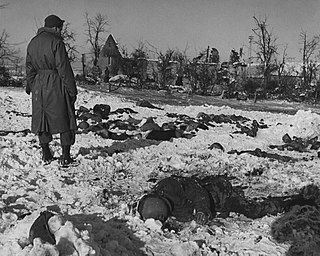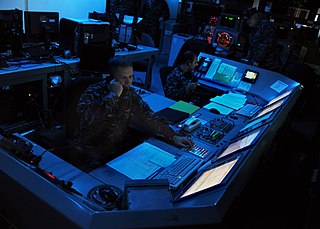Related Research Articles

The Italian Armed Forces encompass the Italian Army, the Italian Navy and the Italian Air Force. A fourth branch of the armed forces, known as the Carabinieri, take on the role as the nation's military police and are also involved in missions and operations abroad as a combat force. Despite not being a branch of the armed forces, the Guardia di Finanza is organized along military lines. These five forces comprise a total of 340,885 men and women with the official status of active military personnel, of which 167,057 are in the Army, Navy and Air Force. The President of the Italian Republic heads the armed forces as the President of the High Council of Defence established by article 87 of the Constitution of Italy. According to article 78, the Parliament has the authority to declare a state of war and vest the powers to lead the war in the Government.

A war crime is a violation of the laws of war that gives rise to individual criminal responsibility for actions by combatants in action, such as intentionally killing civilians or intentionally killing prisoners of war, torture, taking hostages, unnecessarily destroying civilian property, deception by perfidy, wartime sexual violence, pillaging, and for any individual that is part of the command structure who orders any attempt to committing mass killings including genocide or ethnic cleansing, the granting of no quarter despite surrender, the conscription of children in the military and flouting the legal distinctions of proportionality and military necessity.

A civilian casualty occurs when a civilian is killed or injured by non-civilians, mostly law enforcement officers, military personnel, rebel group forces, or terrorists. Under the law of war, it refers to civilians who perish or suffer wounds as a result of wartime acts. The term is generally applied to situations in which violence is committed in pursuit of political goals. During periods of armed conflict, there are structures, actors, and processes at a number of levels that affect the likelihood of violence against civilians.
A civilian is a person not a member of an armed force nor a person engaged in hostilities.

Military operations other than war (MOOTW) are military operations that do not involve warfare, combat, or the threat or use of violence. They generally include peacekeeping, peacebuilding, disaster response, humanitarian aid, military engineering, law enforcement, arms control, deterrence, and multilateralism.
The NATO Medal is an international military decoration which is awarded to various militaries of the world under the authority of the North Atlantic Treaty Organization (NATO). It is manufactured by Eekelers-Centini Intl, of Hemiksem, Belgium.
Marla Ruzicka was an American activist-turned-aid worker. She believed that combatant governments had a legal and moral responsibility to compensate the families of civilians killed or injured in military conflicts.

The proposed invasion of Afghanistan prompted protests with mass demonstrations in the days leading up to the official launch of the war on October 7, 2001. The continuation of the war in Afghanistan from 2001 to 2021 lead to further protest and opposition to hostilities.
United Nations Security Council Resolution 1325 (S/RES/1325), on women, peace, and security, was adopted unanimously by the UN Security Council on 31 October 2000, after recalling resolutions 1261 (1999), 1265 (1999), 1296 (2000), and 1314 (2000). The resolution acknowledged the disproportionate and unique impact of armed conflict on women and girls. It calls for the adoption of a gender perspective to consider the special needs of women and girls during conflict, repatriation and resettlement, rehabilitation, reintegration, and post-conflict reconstruction.
During the War in Afghanistan, according to the Costs of War Project the war killed 176,000 people in Afghanistan: 46,319 civilians, 69,095 military and police and at least 52,893 opposition fighters. However, the death toll is possibly higher due to unaccounted deaths by "disease, loss of access to food, water, infrastructure, and/or other indirect consequences of the war." According to the Uppsala Conflict Data Program, the conflict killed 212,191 people. The Cost of War project estimated in 2015 that the number who have died through indirect causes related to the war may be as high as 360,000 additional people based on a ratio of indirect to direct deaths in contemporary conflicts.

The following items form a partial timeline of the War in Afghanistan. For events prior to October 7, 2001, see 2001 in Afghanistan.
The United Nations Peacekeeping efforts began in 1948. Its first activity was in the Middle East to observe and maintain the ceasefire during the 1948 Arab–Israeli War. Since then, United Nations peacekeepers have taken part in a total of 72 missions around the globe, 12 of which continue today. The peacekeeping force as a whole received the Nobel Peace Prize in 1988.

The war on terror, officially the Global War on Terrorism (GWOT), is a global military campaign initiated by the United States following the September 11 attacks and is the most recent global conflict spanning multiple wars. Some researchers and political scientists have argued that it replaced the Cold War.

Rethink Afghanistan is a 2009 documentary by Robert Greenwald and Brave New Films, about the US military presence in Afghanistan following the terrorist attacks of September 11, 2001.
Tara Sutton is a Canadian journalist and filmmaker whose work in conflict zones has received many awards. She was one of the first international television correspondents to both produce and shoot their own reports and is a pioneer in the field of "video journalism".

Since the September 11 attacks, the United States has carried out drone strikes in Pakistan, Yemen, Somalia, Afghanistan, Iraq and Libya.

Casualty recording is the systematic and continuous process of documenting individual direct deaths from armed conflict or widespread violence. It aims to create a comprehensive account of all deaths within a determined scope, usually bound by time and location.
In international humanitarian law and international criminal law, an indiscriminate attack is a military attack that fails to distinguish between legitimate military targets and protected persons. Indiscriminate attacks strike both legitimate military and protected objects alike, thus violating the principle of distinction between combatants and protected civilians. They differ from direct attacks against protected civilians and encompass cases in which the perpetrators are indifferent as to the nature of the target, cases in which the perpetrators use tactics or weapons that are inherently indiscriminate, and cases in which the attack is disproportionate, because it is likely to cause excessive protected civilian casualties and damages to protected objects.
References
- ↑ "About Us". Campaign for Innocent Victims in Conflict. Retrieved 2010-11-21.
- ↑ "The Campaign For Innocent Victims in Conflict". Zunia. Archived from the original on 2011-07-20. Retrieved 2010-11-28.
- 1 2 "What We Do". Campaign for Innocent Victims in Conflict. Retrieved 2010-12-01.
- ↑ "Civilians Harm and Conflict in Northwest Pakistan". ReliefWeb. 13 October 2010. Retrieved 2010-12-05.
- ↑ "Help us sustain CIVIC's work!". Campaign for Innocent Victims in Conflict. Archived from the original on 2006-12-07. Retrieved 2010-12-02.
- ↑ "Who We Are | Civilians in Conflict". civiliansinconflict.org. Retrieved 2017-02-09.
- ↑ Kessler, Glenn (2004-08-23). "U.S. Activist Mends Lives Torn by War". The Washington Post. Retrieved 2010-12-02.
- ↑ REITMAN, JANET (Jun 2, 2005). "The Girl Who Tried to Save the World: The heroic life and final days of Marla Ruzicka, an American martyr". Rolling Stone. Archived from the original on 2008-06-17.
- ↑ Johnson, Jason B. (April 24, 2005). "LAKEPORT: More than 600 mourn peace activist at service". San Francisco Chronicle.
- ↑ "Campaign for Innocent Victims In Conflict (CIVIC)". A San Francisco Bay Area Progressive Directory. Retrieved 2010-11-28.
- 1 2 3 4 "Key Concepts | Center for Civilians in Conflict". Center for Civilians in Conflict. Retrieved 2017-12-08.
- ↑ "CIVILIANS IN WAR: PAKISTAN". Campaign for Innocent Victims in Conflict. Retrieved 2010-12-01.
- ↑ Gaston, Erica (2009-02-26). "Losing the People: The Cost and Consequences of Civilian Suffering in Afghanistan". The Huffington Post. Retrieved 2010-11-23.
- ↑ "IRAQI CIVILIAN WAR CASUALTIES". IRAQI WAR CASUALTIES. Archived from the original on 2011-07-20. Retrieved 2010-12-02.
- ↑ "CIVILIANS IN ARMED CONFLICT: Civilian Harm and Conflict in Northwest Pakistan" (PDF). CIVIC. Archived from the original (PDF) on 2011-06-09. Retrieved 2010-12-14.
- ↑ "Accomplishments". Campaign for Innocent Victims in Conflict. Retrieved 2010-12-10.
- ↑ "Center for Civilians in Conflict - Making an Impact by Minimizing Civilian Harm". Center for Civilians in Conflict. Retrieved 2017-12-08.